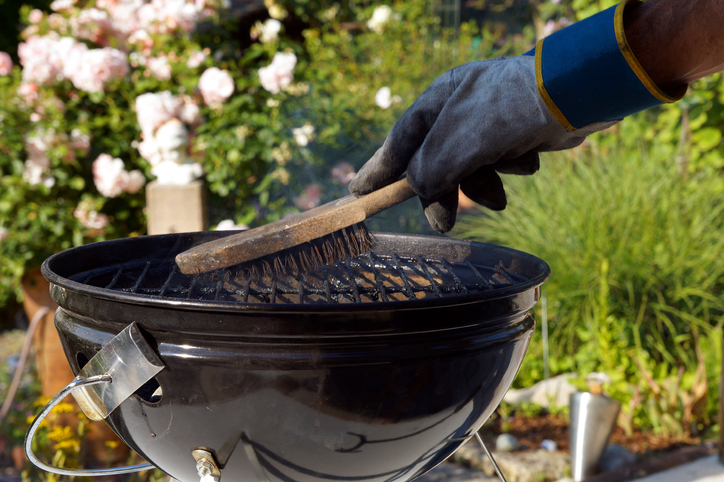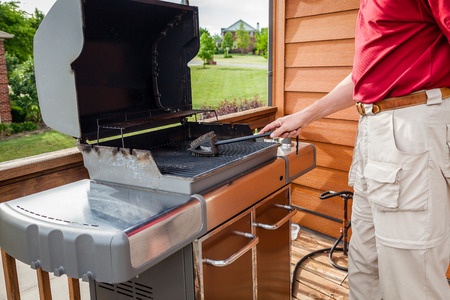- Clean Home
- Backyard & Garden
- How To Clean a Grill
How To Clean a Grill
How to clean a grill. Come Memorial Day, Americans light up - the grills, that is. Stop and think before you light that match or turn on the gas. That grill has been sitting in the yard for six or seven months, accumulating dirt, insects, and rust.
Just as you wouldn't fry an egg in a dirty frying pan, you wouldn't throw a juicy steak on a dirty grate. Would you? I didn't think so. Here's how to clean a grill and prepare it to glow for another season.
How to Clean a Grill and Prep It For Use
To prepare your charcoal grill for use, start by cleaning the cooking grate with a brass grill brush and warm, soapy water. This combination of tools and methods effectively removes dirt and grime from the grate, ensuring a clean surface for food.
If you encounter resistance, try rubbing it lightly with steel wool. Rinse and dry. (Lightly coat cast-iron grates with cooking oil.) Never use oven cleaner when cleaning a grill.
Oven cleaners can damage the finish, and it's a bad idea to apply a caustic substance to the grates where food will be placed. The residue from the oven cleaner can contaminate your food, posing a health risk. It's always better to opt for safer cleaning methods.
Remove last year's ashes. Then, clean the inside and outside of the grill with warm, soapy water. Rinse and wipe dry.
To keep it clean, treat it like any other cooking surface. Wiping up spills immediately before they dry and cook on will make cleanup much easier. (The grill will look nicer, too.)
After each use, while the grates are still warm, clean them with a wire grill brush. If you have cast-iron grates, oil them lightly after cleaning. Then, remove the ashes.
How to Clean a Grill: Gas
If you're like most people, you've got a trusty, much-used gas grill sitting on your patio or deck. And if you're like most people, you last cleaned that thing when you bought it.
Are you crazy? Are you really going to light up a propane tank without checking things out first? I didn't think so.
Here are some tips for cleaning and inspecting your gas grill before you fire up this summer. (Always check your manufacturer's directions before doing anything to your grill. There may be a specific way to clean your particular model.)
Before you fire up:
- Read your owner's manual.
- Bring it outside with you for reference.
- Spread newspapers under your work area to protect your patio or deck.
Shut off the gas in the tank and remove it. (Follow directions in your owner's manual for removing the burner and pulling the gas or venturi tubes off the gas lines.)
Clean any external dirt or grease with a cloth dipped in soapy water. Wipe the grill dry. Spider nests and grease can clog ports (or gas connections).
Remove clogs with a toothpick, wire, or paper clip. Clear the venturi tubes with a non-wire bottlebrush.
How to Clean a Grill Grate
Remove grill grates (or grids) and briquettes, and set them aside.
Wash the burner grates and drip pans with soapy water and a plastic scouring pad, then set them aside. To keep the gas openings at the control panel dry, cover them with plastic bags and/or aluminum foil.
Then, clean the grill's inside and outside with a brass bristle brush and warm, soapy water. Rinse it with a garden hose and wipe it dry.
Remove the plastic/foil covering on the gas openings. Check the hoses for leaks or cracks. Make sure that there are no severe bends in the hoses. Hook up the propane tank.
If it's dented or very rusty, do not use it. There could be a leak. Replace it immediately.
Check for connection leaks by painting the connections with a solution of half water and half soap. Turn on the gas. If any connections bubble, you've got a leak. Tighten the connections.
To clean the briquettes and grate, put them in the grill and flip over so that the greasy side faces the burner. Close the lid and "cook" on high for 15 minutes.
When cool, remove them and scrub them with a brass bristle brush and warm, soapy water. Dry and replace. Oil grates to ward off corrosion.
Replace any disintegrating briquettes. (They usually need replacing once a year.) Then, replace the burner grates and drip pans.
After each use:
- Close the lid and turn the heat high for 15 minutes to keep your gas grill in top-grilling shape.
- Scrape the grates with a wire grill brush.
- If the grates are cast iron, season them with oil.
Clean a grill every six months, or at least at the beginning and end of the grilling season. Winterizing a gas grill is essential before storing it for winter.
Clean the briquettes and grates by flipping them greasy side down, closing the lid, and firing up the grill on high for 15 minutes. Cool and wash with warm, soapy water.
Turn off the gas at the tank and remove the propane unit. Clean the tank with warm, soapy water and wipe it dry. Clean the gas connections with a paper clip.
Clean the outside of the grill and check for chips: sand and touch-up chips with paint designed for high temperatures.
If you store your grill outside, replace the propane unit and cover the grill. After it has sat unused for a season, clean it.
If you store your grill inside, keep the tank off of it. Store the tank upright outside (away from kids and dryer vents). Cover gas line openings with plastic bags to prevent bugs and spiders from nesting there.
- Clean Home
- Backyard & Garden
- How To Clean a Grill























